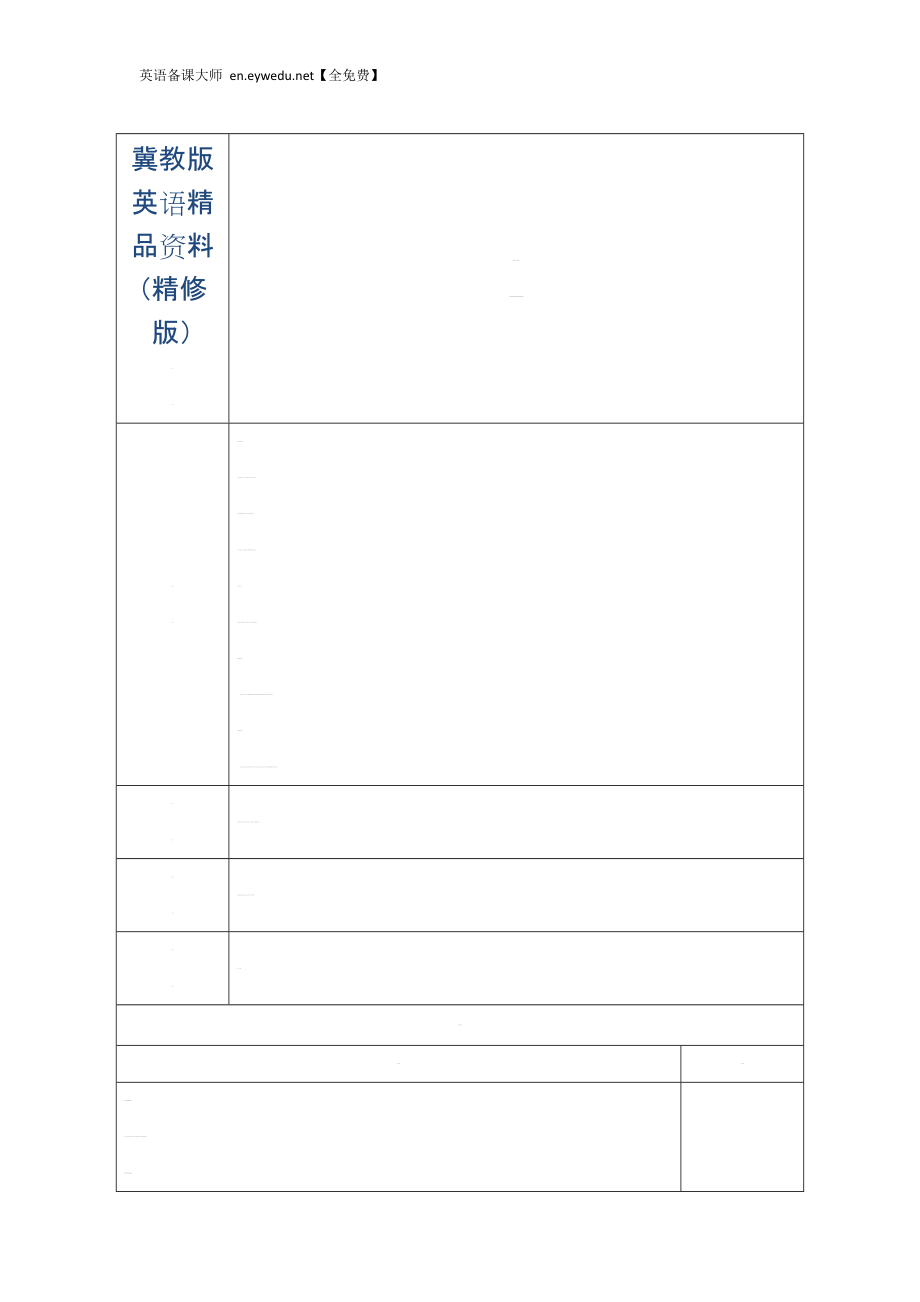《【冀教版】英語五年級(jí)上冊(cè)導(dǎo)學(xué)案Unit4 Lesson 23精修版》由會(huì)員分享,可在線閱讀��,更多相關(guān)《【冀教版】英語五年級(jí)上冊(cè)導(dǎo)學(xué)案Unit4 Lesson 23精修版(3頁珍藏版)》請(qǐng)?jiān)谘b配圖網(wǎng)上搜索���。
1�����、英語備課大師 【全免費(fèi)】
冀教版英語精品資料(精修版)
教學(xué)
內(nèi)容
冀教版 五年級(jí)上冊(cè)
Lesson 23 What Do We Need for the Trip?
教學(xué)
目的
知識(shí)和技能目標(biāo):
1. 學(xué)生能聽懂��、會(huì)說����、認(rèn)讀并書寫下列詞匯those, that.
2. 學(xué)生能理解this, that, these, those所表達(dá)的意思。
3. 學(xué)生能認(rèn)讀��、理解并運(yùn)用下列基本的句型結(jié)構(gòu):I like...
I don’t like...
4.學(xué)生能了解字母組合ow, oa和o在單詞中的發(fā)音及規(guī)則����。
情感態(tài)度目標(biāo):
使學(xué)生樂于學(xué)習(xí)英語,能夠積極地用英語進(jìn)行交流
2�、并通過討論來激發(fā)學(xué)生的學(xué)習(xí)興趣與合作意愿。
學(xué)習(xí)策略目標(biāo):
通過對(duì)比�����、演示讓學(xué)生更易理解�����。讓學(xué)生在學(xué)習(xí)中以比賽、小組討論等方式培養(yǎng)學(xué)生英語思維及互助學(xué)習(xí)模式���。
教學(xué)
重點(diǎn)
學(xué)生能夠用句型“I like...”“I don’t like...” 來介紹自己所喜歡的衣服�。
教學(xué)
難點(diǎn)
正確運(yùn)用this that these those 四個(gè)詞在句中的表達(dá)�。
教學(xué)
準(zhǔn)備
圖片,實(shí)物
教學(xué)過程
教學(xué)設(shè)計(jì)
設(shè)計(jì)意圖
Step 1. Warming up.
T: Hello, boys and girls. How are you today? How’s the weat
3����、her today?
Step 2. New Concepts.
1. Review
T:Do you like the Spring Festival? What do you do for the special holidays?
2. New concepts
T: There are many special holidays in China and some food.
Beijing Duck...do you know? Are they delicious? Today we will have a trip again.
T:What do we n
4、eed for the trip?
Train tickets, food, camera, clothes and so on.
T:What clothes does Li Ming like?
Now Let’s have a look .
PPT:This is near. These are near.
That is far. Those are far.
this that these those
sweater sweaters
shirt trousers
5�����、skirt clothes
T:Okay, now let’s have a chant.
Step 3. Presentations.
1. Practice the sentences :I like... I don’t like...
2. Pair work: point to student’s clothes and say something each other.
3.Group work: (say and write)
Say the sentences in your group and then do Part 3 to
6���、gether.
Step 4. Letters and sounds.
T:This part we learn the pronunciation of the letters.
ow know slow (show, snow)
oa coat boat (goat, soap)
o nose home (hope, note, those )
Find out the rules and try to read.
Step 5. Summary.
Let the students summarize and then check it.
Step 6. Ho
7�、mework:
Make the sentences with "I like... "and "I don’t like...".
板書設(shè)計(jì)
Lesson 23 What do we need for the trip?
I like these red trousers. I don’t like those trousers.
I like this blue sweater. I don’t like that orange sweater.
ow know slow__ __ __
oa coat boat __ __ __
o
8�����、 nose home __ __ __
簡短的問候�,與學(xué)生溝通����,并盡快進(jìn)入到英語學(xué)習(xí)的氛圍中����。然后教師將學(xué)生分成兩組來進(jìn)行比賽���,吸引了學(xué)生的注意力��。
在復(fù)習(xí)環(huán)節(jié)�����,教師設(shè)計(jì)了用中國特有的節(jié)日以及節(jié)日的特點(diǎn)作為導(dǎo)入��,引出北京烤鴨等內(nèi)容���,為這節(jié)課的學(xué)習(xí)做了鋪墊。
以課件形式展示難點(diǎn)���,學(xué)生理解得會(huì)更透徹�。用對(duì)比的方法能更直觀地突出知識(shí)點(diǎn)�。
以節(jié)奏感很強(qiáng)的chant來把英語的知識(shí)和娛樂結(jié)合在一起,既掌握了知識(shí)又體現(xiàn)了英語的趣味性�����。
在情景中運(yùn)用所學(xué)的知識(shí),來介紹你喜歡或不喜歡的衣服��,對(duì)本課的重點(diǎn)知識(shí)加以鞏固�。
語音知識(shí)
9、這塊主要是讓學(xué)生來讀出單詞�,并且思考出更多相似的單詞,通過單詞的呈現(xiàn)找出發(fā)音規(guī)則,學(xué)生的興趣會(huì)非常高�����。
把話語權(quán)交給學(xué)生����,提高學(xué)生積極性的同時(shí),還能培養(yǎng)他們的課后總結(jié)能力�����。
課 后 反 思
圍繞本課我制定了四個(gè)目標(biāo)�。其實(shí)前兩個(gè)目標(biāo)都是針對(duì)四個(gè)代詞的理解,這也是本課的一個(gè)難點(diǎn)��。如何讓學(xué)生能夠正確地理解并能靈活運(yùn)用這四個(gè)詞是我這一課重點(diǎn)要解決的問題。因此我用了對(duì)比���、課件展示等方法讓學(xué)生加深印象。第三個(gè)目標(biāo)是關(guān)于句型的���,這個(gè)句型掌握得好不好還是取決于對(duì)目標(biāo)二單詞的掌握���,所以我抓住重點(diǎn)多練習(xí)取得了不錯(cuò)的效果。在對(duì)語音知識(shí)這塊的教授中�,我把自主權(quán)交給了學(xué)生,鍛煉了學(xué)生獨(dú)立思考的能力�����,也獲得了很好的效果�。
不足之處:由于時(shí)間關(guān)系,在某些環(huán)節(jié)中我留給學(xué)生展示的時(shí)間較少�。由于學(xué)生的學(xué)習(xí)程度不同,在設(shè)定活動(dòng)時(shí)���,我考慮得不夠深入���,下次上課,我一定會(huì)取長補(bǔ)短,提高自己的教學(xué)水平�。
總之,通過這節(jié)課�����,我引領(lǐng)學(xué)生走到真實(shí)的情境中��,緊緊抓住學(xué)生�,讓學(xué)生積極參與到課堂中來,通過各種句型操練與表演�����,大大提高了學(xué)生的語言綜合運(yùn)用能力����,同時(shí)注重讓學(xué)生手腦并用,并恰當(dāng)運(yùn)用小組合作形式���,有效地培養(yǎng)了英語思維模式��,并為學(xué)生學(xué)習(xí)策略的培養(yǎng)打下了基礎(chǔ)����。
 【冀教版】英語五年級(jí)上冊(cè)導(dǎo)學(xué)案Unit4 Lesson 23精修版
【冀教版】英語五年級(jí)上冊(cè)導(dǎo)學(xué)案Unit4 Lesson 23精修版

